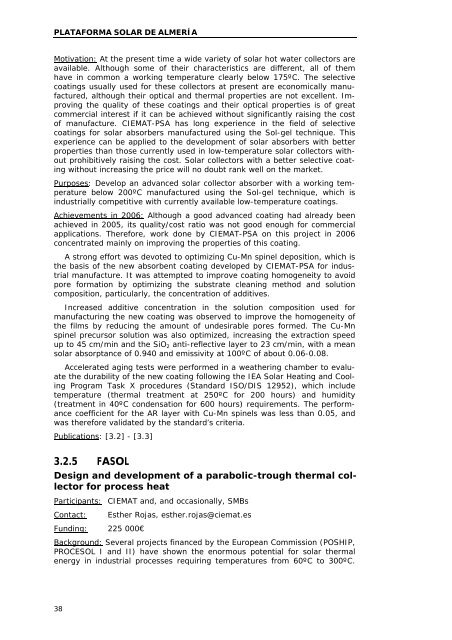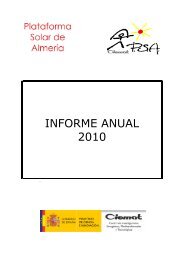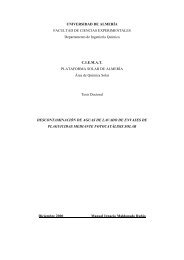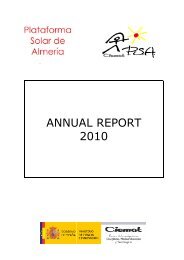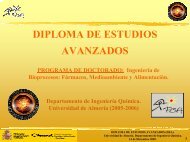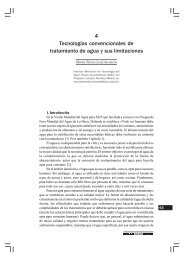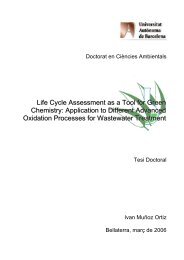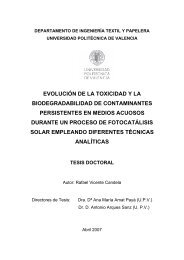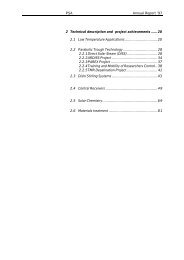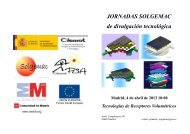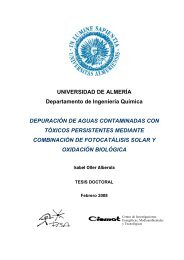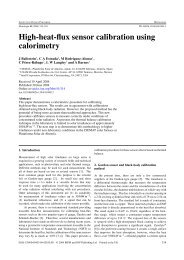Annual Report 2006 - Plataforma Solar de AlmerÃa
Annual Report 2006 - Plataforma Solar de AlmerÃa
Annual Report 2006 - Plataforma Solar de AlmerÃa
Create successful ePaper yourself
Turn your PDF publications into a flip-book with our unique Google optimized e-Paper software.
PLATAFORMA SOLAR DE ALMERÍA<br />
Motivation: At the present time a wi<strong>de</strong> variety of solar hot water collectors are<br />
available. Although some of their characteristics are different, all of them<br />
have in common a working temperature clearly below 175ºC. The selective<br />
coatings usually used for these collectors at present are economically manufactured,<br />
although their optical and thermal properties are not excellent. Improving<br />
the quality of these coatings and their optical properties is of great<br />
commercial interest if it can be achieved without significantly raising the cost<br />
of manufacture. CIEMAT-PSA has long experience in the field of selective<br />
coatings for solar absorbers manufactured using the Sol-gel technique. This<br />
experience can be applied to the <strong>de</strong>velopment of solar absorbers with better<br />
properties than those currently used in low-temperature solar collectors without<br />
prohibitively raising the cost. <strong>Solar</strong> collectors with a better selective coating<br />
without increasing the price will no doubt rank well on the market.<br />
Purposes: Develop an advanced solar collector absorber with a working temperature<br />
below 200ºC manufactured using the Sol-gel technique, which is<br />
industrially competitive with currently available low-temperature coatings.<br />
Achievements in <strong>2006</strong>: Although a good advanced coating had already been<br />
achieved in 2005, its quality/cost ratio was not good enough for commercial<br />
applications. Therefore, work done by CIEMAT-PSA on this project in <strong>2006</strong><br />
concentrated mainly on improving the properties of this coating.<br />
A strong effort was <strong>de</strong>voted to optimizing Cu-Mn spinel <strong>de</strong>position, which is<br />
the basis of the new absorbent coating <strong>de</strong>veloped by CIEMAT-PSA for industrial<br />
manufacture. It was attempted to improve coating homogeneity to avoid<br />
pore formation by optimizing the substrate cleaning method and solution<br />
composition, particularly, the concentration of additives.<br />
Increased additive concentration in the solution composition used for<br />
manufacturing the new coating was observed to improve the homogeneity of<br />
the films by reducing the amount of un<strong>de</strong>sirable pores formed. The Cu-Mn<br />
spinel precursor solution was also optimized, increasing the extraction speed<br />
up to 45 cm/min and the SiO 2 anti-reflective layer to 23 cm/min, with a mean<br />
solar absorptance of 0.940 and emissivity at 100ºC of about 0.06-0.08.<br />
Accelerated aging tests were performed in a weathering chamber to evaluate<br />
the durability of the new coating following the IEA <strong>Solar</strong> Heating and Cooling<br />
Program Task X procedures (Standard ISO/DIS 12952), which inclu<strong>de</strong><br />
temperature (thermal treatment at 250ºC for 200 hours) and humidity<br />
(treatment in 40ºC con<strong>de</strong>nsation for 600 hours) requirements. The performance<br />
coefficient for the AR layer with Cu-Mn spinels was less than 0.05, and<br />
was therefore validated by the standard’s criteria.<br />
Publications: [3.2] - [3.3]<br />
3.2.5 FASOL<br />
Design and <strong>de</strong>velopment of a parabolic-trough thermal collector<br />
for process heat<br />
Participants: CIEMAT and, and occasionally, SMBs<br />
Contact:<br />
Esther Rojas, esther.rojas@ciemat.es<br />
Funding: 225 000€<br />
Background: Several projects financed by the European Commission (POSHIP,<br />
PROCESOL I and II) have shown the enormous potential for solar thermal<br />
energy in industrial processes requiring temperatures from 60ºC to 300ºC.<br />
38


